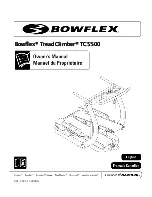
UHF Analog Driver/Transmitter/
Chapter 4, Circuit Descriptions
Translator
LX Series, Rev. 3
4-2
U1, CR4 and its associated components,
varies the gain of the pin attenuator on
the front end of the board to maintain a
constant output level. The pin
attenuator has an overall adjustment
range of approximately 50 dB.
There is a comparator that looks at the
pin attenuator voltage and generates an
alarm if the pin attenuator is close to
running out of range. This alarm is
likely to occur if the RF input signal to
the receiver is weak or missing. This
alarm is received by the microcontroller
that passes it along to the transmitter's
system controller, which mutes the
signal in the IF processor until the fault
goes away.
4.1.2 UHF Mixer/PLL Board
(1304021; Appendix B)
This board converts the RF input to the
receiver to a 44 MHz IF. It consists of a
Mixer, a local oscillator and some IF
amplifiers used to make up for the loss
of the mixer.
The Local oscillator signal is generated
by the VCO (U3), which operates directly
at the LO frequency of the channel
center fre 44 MHz. The
oscillator is phase locked to a 10 MHz
standard by U2, U8, and their associated
components. TP1 shows the AFC
voltage, which is also sent back to the IF
ALC board to be displayed on the system
level controller. The variable resistor
R30 sets the LO output level to +10
dBm into the mixer U4. This is done by
looking at the LO sample at J2 with a
spectrum analyzer, adjusting R30 until
the level is -10 dBm. This ensures that
the mixer gets the correct level, as the
sample is 20 dB down from the level into
the mixer.
Mixer U4 converts the RF input at J1 to
an IF frequency of 44 MHz. L13, L14
and C56 form a low pass filter, which
rejects any unwanted higher frequency
conversion products. U5 and U9 amplify
the signal, which exits the board at J5.
There are two jumpers on J3 and J4 that
allow the user to switch in a 10 dB
attenuator if the input level to the receiver
is too high. Normally the jumpers are
connected between pins 1 and 2 of each
connector, but if the user has a high input
level, they can be switched to connect
pins 2 and 3 of each connector, which
switches in the 10 dB pad.
The A/V ratio of the incoming signal can
be adjusted via an external front panel
pot, which controls the bias on pin
attenuator DS3. The pin attenuator
controls the Q of a notch set at the aural
IF carrier frequency, set by C41 and L7.
The A/V ratio control is used if the
incoming signal has an aural carrier that is
too high relative to the visual carrier.
4.1.3 UHF Preamplifier Board
(1304092; Appendix B)
This board filters and amplifies the low
level RF input signal to the receiver. It
consists of two two-pole bandpass filters
and a dual stage preamplifier. The filters
are tuned at the RF channel frequency and
are about 8 MHz wide. They are intended
to filter off the unwanted image product
88 MHz below the Channel center
frequency. Each filter is a combination
micro-strip lumped element filter. The
center frequency of the filter is set by C10
and C11 for the input filter, and C20 and
C21 for the output filter.
The input filter also has provisions to
insert a +12V DC signal onto the center
conductor of the receiver's RF input to
power an external preamp. The jumper
W1 on J2 controls whether or not the DC
bias is applied to the center conductor.
When it is connected between pins 1 and
2, the +12V bias is applied. When it is
between pins 2 and 3, there is no bias
applied. The presence of the DC bias is
displayed on a front panel LED on the
sled.
CAUTION: Do not hook up the RF
input to any test equipment with the
DC bias applied. Always move the
Содержание INNOVATOR
Страница 99: ...APPENDIX A LX SERIES ANALOG SYSTEM SPECIFICATIONS...
Страница 102: ...APPENDIX B DRAWINGS AND PARTS LISTS...
Страница 105: ...APPENDIX C TRANSMITTER LOG SHEET...
















































